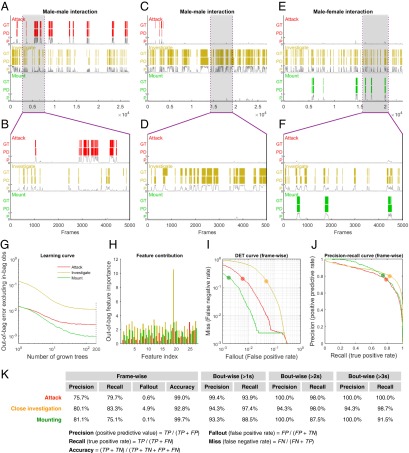Fig. 4.
Supervised classification of social behaviors. (A–K) Classification of attack, mounting, and closeinvestigation using TreeBagger, a random forest classifier. (A–F) Raster plots showing manual annotations of attack, close investigation, and mounting behaviors, as the ground truth, vs. the machine learning classifications of these social behaviors. Three representative videos with different experimental conditions were used as the test set. A and C illustrate two representative examples of male–male interactions. GT, ground truth; P, probability; PD, machine classification/prediction. (G) Learning curve of different behavior classifiers represented by out-of-bag errors as a function of the number of grown trees. (H) Contribution of distinct features to individual classifiers. See Supporting Information for a complete list and descriptions of features. (I) DET curve representing the false negative rate vs. the false positive rate in a framewise manner. (J) Precision-recall curve representing true positive rate vs. positive predictive value in a framewise manner. (K) Table of precision, recall, fallout, and accuracy at the level of individual frames, as well as precision and recall at the level of individual behavioral episodes (“bouts”) for a range of minimum bout durations (>1 s, >2 s, and >3 s). Classification thresholds in A–F and K are 0.55 (attack), 0.5 (close investigation), and 0.4 (mounting) and are highlighted in red, orange, and green dots, respectively, in I and J.

